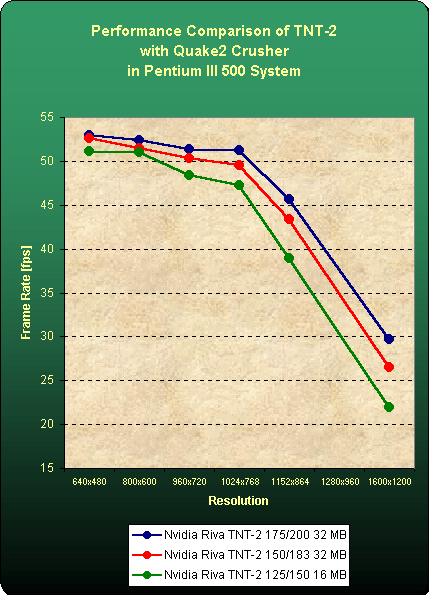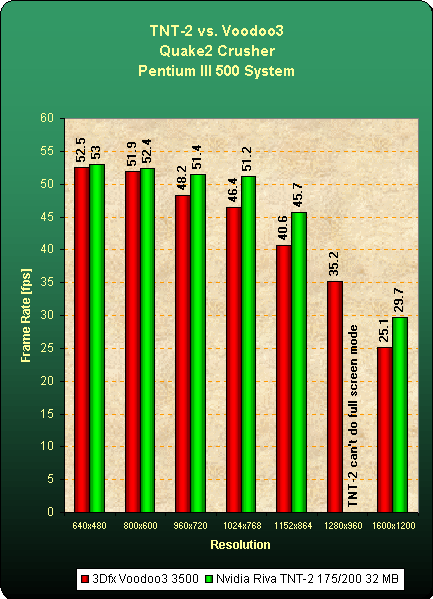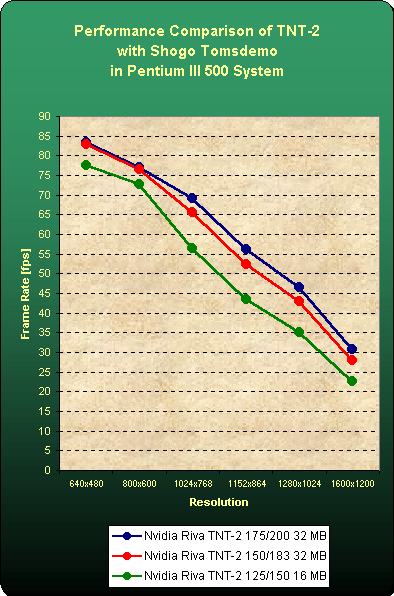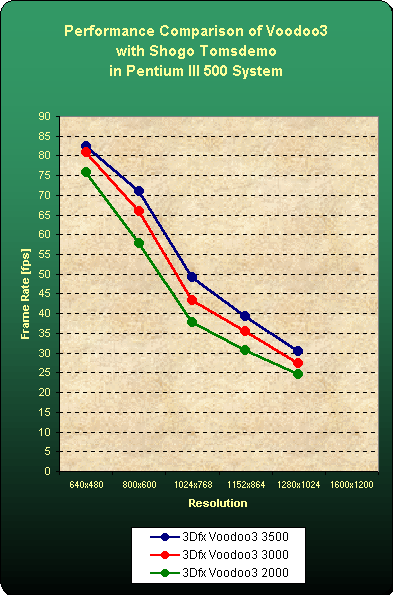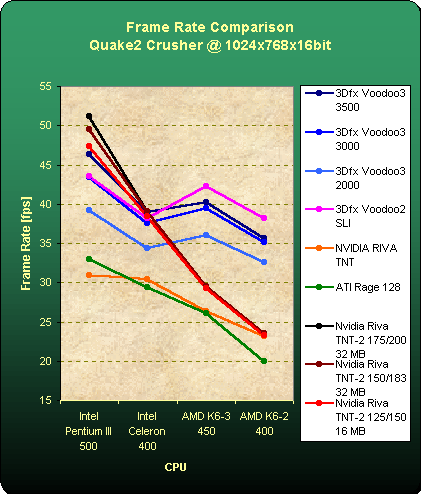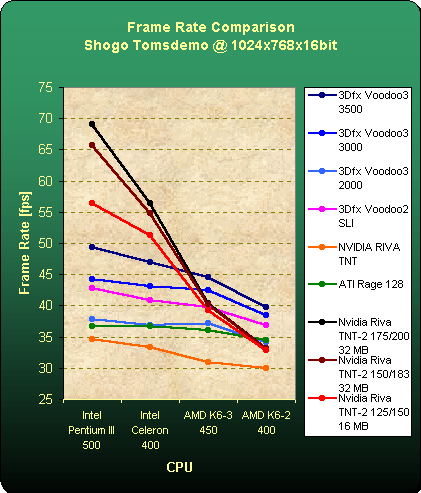NVIDIA rocks the Boat with TNT2
2D Performance
I tested TNT2 with Winstone99 just to find out that again the results were identical to the other tested graphics cards. None of the tested cards showed any performance decrease in Winstone when switching the desktop color depth from 16 to 32 bit. I recently received a mail from a 3Dlabs-employee,who told me that Winstone would be pretty useless for the evaluation of 2D-performance. Under Winstone the graphics driver is waiting for the CPU to send its next instruction or data, which is why all cards a performing the same as soon as the graphics driver is faster than the rest of the system. He suggested that I run Winbench instead. You can see that I still haven't done that. The reason for this is pretty simple. If the hectic test run of Winstone is already too slow for today's 2D drivers, what about us actually using office applications? We are certainly slower than Winstone, so that a faster 2D graphics driver has got even less impact on our real world computing experience. Thus it seems pretty pointless to test 2D-performance with Winbench, because the 2D-performance of a card may be a great as it wants, it doesn't have the slightest impact on real world computing. My conclusion about TNT2's 2D performance is: It's damn fast, but you won't notice the slightest difference to Voodoo3, Rage128 or TNT.
32 Bit Rendering Performance
You certainly can still remember, NVIDIA does actually not despise the idea of 32-bit rendering and TNT2 does 32-bit rendering, whilst 3Dfx's Voodoo3 doesn't. The question is now if 3Dfx is right, is 32 bit rendering a frame rate killer indeed and thus pointless?
I only used Quake2 for the comparison between 16 and 32 bit rendering, because other games that support 32 bit rendering are either too old like e.g. 'Incoming' or not complex enough and thus scoring equally in both color depths as e.g. Turok2.
The impact of 32 bit rendering in Quake2 lies somewhere between 1 and 17%, Quake2 is still playable at 32 bit as well in the vast majority of resolutions. NVIDIA must have done a pretty good job with the rendering pipeline as well as the memory interface, TNT was not as great at 32-bit rendering as TNT2 is.
TNT2 At Different Clock Frequencies - Quake2 Crusher
Brett 'Three Fingers' Jacobs' Crusher Demo is my favorite Quake2 benchmark, because it puts the Quake2-performance of a 3D-card into a worst case scenario. This means that the scores in this benchmark are pretty close to the lowest frame rates you should occur when playing online and as long as the lowest scores are high enough, you don't have any reasons to worry. The high scores produced by the Demo1 or even Massive1-demos don't really give you a good idea about the frame rate you can expect when playing a heavy multi player session. Crusher is definitely CPU-bound, which is why you cannot reach more than 55 fps at any resolution with a Pentium III 500. Whoever reports higher results with any 3D card is not telling you the truth.
| Resolution | Nvidia Riva TNT-2 175/200 32 MB | Nvidia Riva TNT-2 150/183 32 MB | Nvidia Riva TNT-2 125/150 16 MB |
| 640x480 | 53 | 52.6 | 51.1 |
| 800x600 | 52.4 | 51.5 | 51 |
| 960x720 | 51.4 | 50.3 | 48.4 |
| 1024x768 | 51.2 | 49.5 | 47.3 |
| 1152x864 | 45.7 | 43.4 | 38.9 |
| 1280x960 | Only in window | Only in window | Only in window |
| 1600x1200 | 29.7 | 26.5 | 21.9 |
It is amazing to see that TNT2 is pretty much CPU limited in Crusher up to a resolution of 1024x768. This means that in those resolutions TNT2 will score even higher with a faster CPU. 1152x864 is where finally the 3D-chip limitation kicks in, but look at those numbers! TNT2 scores almost 46 fps at 1152x864! It's a shame that the current driver doesn't support 1280x960 in full screen mode, because I am sure that TNT2 at 175/200 will still score close to 40 fps in Crusher, which makes this resolution definitely playable. A Crusher result of almost 30 fps at 1600x1200 shows that even this resolution is still almost playable.
Underneath you'll find the scores of Voodoo3:
Get Tom's Hardware's best news and in-depth reviews, straight to your inbox.
| Resolution | 3Dfx Voodoo3 3500 | 3Dfx Voodoo3 3000 | 3Dfx Voodoo3 2000 |
| 640x480 | 52.5 | 52.1 | 51.8 |
| 800x600 | 51.9 | 51.9 | 49.5 |
| 960x720 | 48.2 | 46.5 | 42.3 |
| 1024x768 | 46.4 | 43.4 | 39.2 |
| 1152x864 | 40.6 | 37.4 | 32.4 |
| 1280x960 | 35.2 | 33 | 27.8 |
| 1600x1200 | 25.1 | 22.6 | 18.6 |
Voodoo3 is already starting to dive at 960x720 and at 1152x864 it's 5 fps behind TNT2. The next chart makes comparing the two chips a lot easier:
This chart shows pretty obvious who's the real king in Quake2 now. You can easily see that TNT2 is always faster than Voodoo3. What you cannot see on this chart though is that even TNT2 125/150 is scoring almost as well as Voodoo3 3500, and that's maybe the most remarkable thing.
TNT2 At Different Clock Frequencies - Shogo Tomsdemo
Tomsdemo for Shogo is currently one of the best real world benchmarks for Direct3D-games. Shogo may not be quite as cool as Halflife or Unreal, but at least it's graphic engine works without any flaws and the benchmarking procedure isn't quite as painful and depressing as with the two mentioned games. Shogo is a DirectX6-game, it is using multi-texturing and can even support bump mapping. All in all it's got a pretty nice and sophisticated engine.
I used the following settings in Shogo:
- High detail
- Optimized surfaces enabled
- Triple buffering enabled
- Sound, music and movies disabled
- Joystick disabled
I found that enabling 'optimized surfaces' speeds up TNT, TNT2 and Rage128 by a significant amount. It doesn't do anything for 3Dfx-cards though.
| Resolution | Nvidia Riva TNT-2 175/200 32 MB | Nvidia Riva TNT-2 150/183 32 MB | Nvidia Riva TNT-2 125/150 16 MB |
| 640x480 | 83.5 | 82.9 | 77.5 |
| 800x600 | 77.1 | 76.4 | 72.6 |
| 1024x768 | 69.1 | 65.7 | 56.4 |
| 1152x864 | 56.1 | 52.5 | 43.4 |
| 1280x1024 | 46.5 | 43 | 35.2 |
| 1600x1200 | 30.8 | 27.9 | 22.7 |
I guess 46.5 fps at 1280x1024 resolution is pretty cool really.
| Shogo Tomsdemo Frame Rate [fps] | 3Dfx Voodoo3 3500 | 3Dfx Voodoo3 3000 | 3Dfx Voodoo3 2000 |
| 640x480 | 82.4 | 81 | 75.8 |
| 800x600 | 71 | 65.9 | 57.9 |
| 1024x768 | 49.3 | 43.4 | 37.9 |
| 1152x864 | 39.4 | 35.5 | 30.6 |
| 1280x1024 | 30.4 | 27.5 | 24.5 |
| 1600x1200 | Fail | Fail | Fail |
With Voodoo3 you can't really play Shogo at a resolution of 1280x1024, 30 fps are also completely against 3Dfx's policy, claiming that anything less than 60 fps sucks badly. I guess this means that Voodoo3-owners can play Shogo only at 800x600 then, whilst a TNT2-owner can nicely enjoy the better detail of 1024x768. The Voodoo3 does not run Shogo at 1600x1200 correctly, all moving object are lacking textures. This is either just a bug in the driver or it's due to Voodoo3's lack of AGP-texturing support.
Here the direct comparison chart:
TNT2 kicks the butt of Voodoo3 really badly in Shogo. TNT2 is really strong at Direct3D.
Comparison Of Voodoo3 With Actual 3D-Cards - Quake2 Crusher
Now it's time to take the focus off the fight between TNT2 and Voodoo3 and look at the other 3D cards out there running in systems with four different CPUs.
| Quake2 Crusher Frame Rate [fps] | Intel Pentium III 500 | Intel Celeron 400 | AMD K6-3 450 | AMD K6-2 400 |
| 3Dfx Voodoo3 3500 | 46.4 | 38.9 | 40.2 | 35.7 |
| 3Dfx Voodoo3 3000 | 43.4 | 37.6 | 39.4 | 35.1 |
| 3Dfx Voodoo3 2000 | 39.2 | 34.3 | 36.0 | 32.6 |
| 3Dfx Voodoo2 SLI | 43.5 | 38.2 | 42.3 | 38.2 |
| NVIDIA RIVA TNT | 30.9 | 30.4 | 26.4 | 23.1 |
| ATI Rage 128 | 33 | 29.4 | 26.1 | 20 |
| Nvidia Riva TNT-2 175/200 32 MB | 51.2 | 39.1 | 29.5 | 23.5 |
| Nvidia Riva TNT-2 150/183 32 MB | 49.5 | 39.1 | 29.5 | 23.5 |
| Nvidia Riva TNT-2 125/150 16 MB | 47.3 | 38.5 | 29.3 | 23.3 |
As long as an Intel CPU is being used, TNT2 is ahead of the whole competition. However, it's also interesting to see that the different clock speeds of TNT2 do only make a difference in Q2-Crusher when your CPU is faster than a Celeron 400. Until TNT2's driver doesn't get some really good 3DNow!-enhancements, 3Dfx will stay the 3D-chip maker for the owners Socket7-systems. The TNT2-driver 0172b is already a step into the right direction, it makes the TNT2 perform pretty much identical to a Voodoo2-SLI with AMD K6-2 and K6-3.
Comparison Of Voodoo3 With Actual 3D-Cards - Shogo Tomsdemo
| Shogo Tomsdemo Frame Rate [fps] | Intel Pentium III 500 | Intel Celeron 400 | AMD K6-3 450 | AMD K6-2 400 |
| 3Dfx Voodoo3 3500 | 49.3 | 47 | 44.6 | 39.8 |
| 3Dfx Voodoo3 3000 | 44.2 | 43.1 | 42.5 | 38.4 |
| 3Dfx Voodoo3 2000 | 37.9 | 36.8 | 37.1 | 34.1 |
| 3Dfx Voodoo2 SLI | 42.8 | 40.9 | 39.7 | 36.9 |
| NVIDIA RIVA TNT | 34.6 | 33.4 | 31 | 29.9 |
| ATI Rage 128 | 36.7 | 36.7 | 36 | 34.4 |
| Nvidia Riva TNT-2 175/200 32 MB | 69.1 | 56.4 | 40.4 | 33.2 |
| Nvidia Riva TNT-2 150/183 32 MB | 65.7 | 54.8 | 40.3 | 33.2 |
| Nvidia Riva TNT-2 125/150 16 MB | 56.4 | 51.3 | 39.3 | 32.9 |
In Shogo TNT2 is way ahead of its competitors on Intel platforms, but you can also see its CPU-dependency. The driver 0172b lets TNT2 score the same as Voodoo3 3500 on a K6-3-system, as you will see once I've ran the benchmarks again and updated the scores. Interestingly ATI's Rage128 scores almost identically to Voodoo3 2000, which I find quite remarkable.
Please note also that TNT2 at 175/200 is exactly double as fast in Shogo as TNT! It doesn't happen very often that the new product of a company shows a performance increase of 100% over the previous product!
Current page: 2D Performance
Prev Page The Boards Next Page AGP-Performance Test With S3's Quake2 Mon2-Demo
